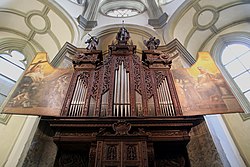Wöckherl organ in Vienna
| Wöckherl organ in Vienna | |
|---|---|

|
|
| General | |
| place | Franciscan Church (Vienna) |
| Organ builder | Johann Wöckherl |
| Construction year | 1642 |
| Last renovation / restoration | 2009–2011 by Kuhn |
| Technical specifications | |
| Number of registers | 20th |
| Number of rows of pipes | 30th |
| Number of manuals | 2 |
| Wind chest | Slider drawer |
| Tone tract | mechanically |
| Register action | mechanically |
The Wöckherl organ in the Vienna Franciscan Church is the oldest playable organ in Vienna . The instrument by Johann Wöckherl from 1642 has 20 registers , which are distributed over two manuals and pedal. Orgelbau Kuhn carried out a restoration in 2009/2010 , which included the reconstruction of three lost registers.
Building history
The organ was built in 1642 by the organ builder Johann Wöckherl (around 1594–1660) - also referred to in literature as Johann Weckerl - in the central niche of the choir of the Vienna Franciscan Church. The purchase contract for this was signed on July 14, 1642.
In the 18th century a high altar was erected in front of the Wöckherl organ . As a result, the instrument was no longer “hidden” and no longer visible from the church. Since then, the new organ on the gallery has been used for liturgical and concert performances . These circumstances contributed to the fact that the Wöckherl organ was essentially preserved in its original form (with the case, the manual shop and the pipework), with only minor repairs and adjustments being made.
In March 2009 Orgelbau Kuhn began to restore the organ for around 1.1 to 1.3 million euros. The re-inauguration was on March 26, 2011.
description
The organ has 20 registers, two manuals and a pedal, each with a short sub-octave in a typical mid-tone tuning . Another special feature are subsemitonies for G sharp / flat, Eb 1 / D flat 1 and G sharp 1 / flat 1 in the positive chest. The organ work with mechanical action and slide chests is located in a case with rich ornamental carved decoration. The organ can be played with closed and open double doors, which are painted figuratively, and this special feature is unique in the Viennese organ landscape .
Disposition
|
|
|
|||||||||||||||||||||||||||||||||||||||||||||||||||||||||||||||||||
- W = Wöckherl (1642)
- K = Kuhn (2010)
Web links
- Wöckherl organ - Vienna's oldest organ in Franciscans in Austria and South Tyrol
- Portrait of the Wöckherl organ at Orgelbau Kuhn AG
- The Wöckherl organ in the organ database www.orgelmusik.at
- The Wöckherl organ in the Vienna Franciscan Church. Lecture by Martin Macheiner, Tonmeistertagung 2012 (Cologne).
Individual evidence
- ↑ a b Federal Monuments Office : Hidden Organ Complete Work of Art ; Retrieved October 3, 2010.
- ^ Oesterreichisches Musiklexikon . Publishing house of the Austrian Academy of Sciences, Vienna 2006, ISBN 3-7001-3067-8 . (Volume 5)
- ^ Archdiocese of Vienna : Vienna's oldest organ "whistles from the last hole" ; Retrieved October 3, 2010.
- ↑ Die Presse : On the trail of the organ builder. ( Memento of July 21, 2009 in the Internet Archive ) July 18, 2009, accessed on October 3, 2010.
- ^ Orgelbau Kuhn : A particularly valuable order ; Retrieved October 3, 2010
